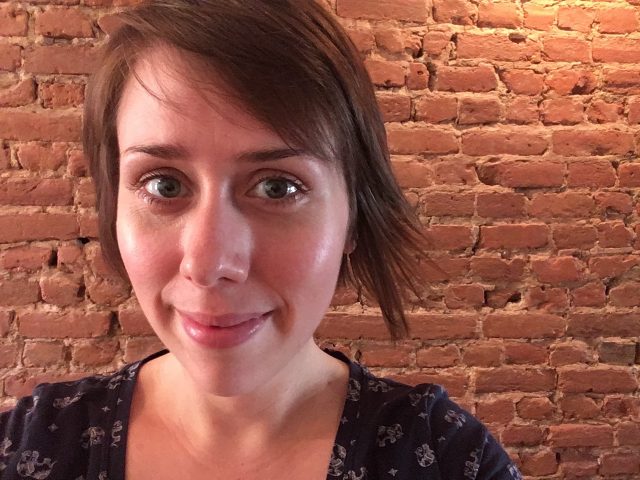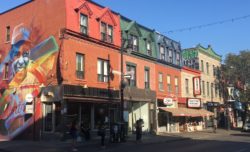Geographer's Space
The French Language in Louisiana and Quebec
Richard Campanella initiates a cross cultural connection in an interview with French Canadian Lisanne Gamelin
Published: December 1, 2017
Last Updated: July 1, 2023

Courtesy of Lisanne Gamelin
Boulevard Saint-Laurent in Montreal
One basic goal of the humanities is to engage people in cross-cultural discussions toward a better understanding of people and place, past and present. That’s exactly what happened at, of all places, a recent Louisiana Endowment of the Humanities soiree marking the release of the summer 2017 Louisiana Cultural Vistas, where I was fortunate enough to strike up a conversation with a young French Canadian named Lisanne Gamelin. You’ll meet Ms. Gamelin in a moment, but suffice to say that our conversation shed light on the social geography of Louisiana French–speakers in the 1800s—and the decline of the language in the 1900s—by assessing the status of French in Montreal and Quebec today. What follows is an edited email interview I conducted with Ms. Gamelin in September 2017, after she had returned home.
Tell us about yourself, your interests in language, and what you were up to in Louisiana.
I’m a Francophone from Quebec in eastern Canada. After returning from a year in Texas where I became bilingual, I completed my degree in History and Film Studies at Concordia, an English-speaking university in Montreal. I have worked for exchange students’ organizations and as an event planner for a festival. I was in Louisiana from April to July 2017, where I extended my network to Louisiana’s cultural sector, including in Arnaudville in Cajun country, at a small arts and culture collective called NUNU in Baton Rouge, and in New Orleans at the Jazz Museum.
Aside from differing population sizes (of Quebec and Louisiana, and of Montreal and New Orleans), what are the main reasons why the French language has thrived in your homeland but declined here?
It was a long struggle, going back to the end of the French and Indian War. At that time, the French-speaking populations along the Saint Lawrence River, now the province of Quebec, were allowed to stay and speak French, whereas the Acadians, also French speakers from present-day Nova Scotia, were deported [and eventually resettled in] Louisiana.
It was believed a “revenge of the cradle” would occur, as the Church encouraged French Canadians to have large families. It failed in the long run partly due to an increased English-speaking immigration, including Loyalists from the States at the end of the War of Independence, and because immigration from France was completely shut down.
For almost two hundred years, French speakers in Quebec remained second-class citizens even if they formed a majority in their province. It wasn’t until the “Quiet Revolution” in the 1960s, when French-speaking politicians started chanting “Maîtres chez nous” (“Masters at home”), that changes started. It would result in the instauration of Bill 101 in 1977. The law dictated French as the language of business, obligated French-only signage (later modified to include limited English signage as well), and mandated that Francophones and immigrants send their children to French-speaking schools until the age of seventeen.
Whenever I explain Bill 101 to Louisianans, I often heard the word “draconian,” as if this law infringed on individual liberties. To be fair, there are people in Quebec arguing the same thing, or that the law prevents French speakers from achieving their true potential by holding on too much to their language. I believe preserving French is a collective effort, but that bilingualism is essential to our country’s prosperity. I contribute by becoming bilingual myself, and am pleased when I meet fellow English-speaking Canadians doing the same.

Lisanne Gamelin
Let’s talk specifically about the French language in Montreal. What sort of spatial patterns of Francophones and Anglophones do we see? Do they live separately?
Historically, Francophones and Anglophones lived in separate neighborhoods in Montreal. Those east from Boulevard Saint-Laurent were predominantly French-speaking, whereas those west were English-speaking. Nowadays, a better social mixing in terms of language exists in Montreal’s neighborhoods, but old habits die hard. You will still hear the infamous Montreal bilingual greeting “Bonjour-Hi” in the downtown area, west of Saint-Laurent. Whereas in Hochelaga, a former French-speaking working-class area and now an up-and-coming neighborhood located in the east, you will hear a simple “Allô” greeting. Even in the eastern parts of Montreal, you will get service in English too, but not as easily as you would in the western part of the city. However, French service is mandatory by law.
Tell us about the Boulevard Saint-Laurent and its role or position in the linguistic geography of Montreal.
Boulevard Saint-Laurent—or as it is also locally known, “La Main,” a term even used by French speakers—has always been the invisible line between French and English parts of the city. For instance, the Plateau neighborhood is separated by this boulevard. The east part is occupied mainly by Montreal’s French-speaking local celebrities and, in the last few decades, a new wave of young professionals emigrating from France. West of the boulevard, in what is called “McGill ghetto,” students from McGill University, a top English-speaking university, tend to move into this part of the Plateau for proximity and cheaper housing than in some other western neighborhoods like Westmount.
From your learnings about New Orleans, what sort of parallels or differences do you see between the linguistic geography of Montreal and New Orleans, and of Boulevard Saint-Laurent and Canal Street?
I was intrigued to learn that a similar pattern to Boulevard Saint-Laurent also existed in New Orleans in the form of Canal Street. However, from what I understood, the linguistic separation of New Orleans was a conscious decision, like honoring Lafayette and Jackson in public parks in each other’s parts. (Editor’s note: from 1836 to 1852, New Orleans was officially subdivided into three semi-autonomous municipalities, largely along ethnic and linguistic lines, with Canal Street forming the division separating the mostly Francophone First Municipality from the mostly Anglophone Second Municipality.) The “ghettoization” of Montreal happened more organically.
What struck you about the two cities’ built environments?
I was impressed by the diversity of New Orleans’ architecture, whether it be the mix of French-named streets with Spanish architecture in the French Quarter or the shotgun houses [in the faubourgs], making it unique in the United States. Similarly, many people consider Montreal the most European city of North America. You will find colonial-period buildings like churches integrated in recent structures, and archways made into gateways to universities or hospitals.
In terms of street names, I was often amazed by how New Orleanians would pronounce the French Quarter streets, like Decatur or Chartres. It was the opposite of the way I would have pronounced it as a French speaker. In Montreal, English speakers do not anglicize street names, but rather pronounce them the French way. For example, no one would say “St. Lawrence Boulevard.”
I also couldn’t help but notice that Montreal and New Orleans had another thing in common: potholes! I argued with many New Orleanians that Montrealers had it worse—until we went for a ride. It was a tough call.
New Orleans and Louisiana were founded by francophone French Canadians. As a French Canadian yourself, what were your impressions of modern New Orleans and Louisiana in regard to the French language?
It surprised me that most French speakers weren’t even located in New Orleans but rather closer to Lafayette. I was saddened (although not surprised) to hear French, including Cajun and Creole, was illegalized for a time, creating this generational gap among French speakers in Louisiana. However, similar discriminatory practices also occurred throughout Canada. Seeing French barely visible in terms of public signage also disappointed me. When I could find someone who spoke French, I realized how different our accents and word choice were, making it sometimes difficult to communicate freely.
Any plans to return to Louisiana, or to keep Louisiana in your life?
Louisiana was so welcoming; it was hard to say goodbye. I will be back, that is for sure.
Richard Campanella, a geographer with the Tulane School of Architecture, is the author of Bienville’s Dilemma, Geographies of New Orleans, Bourbon Street: A History, Lincoln in New Orleans and other books. He may be reached through richcampanella.com, [email protected]; or @nolacampanella on Twitter.
